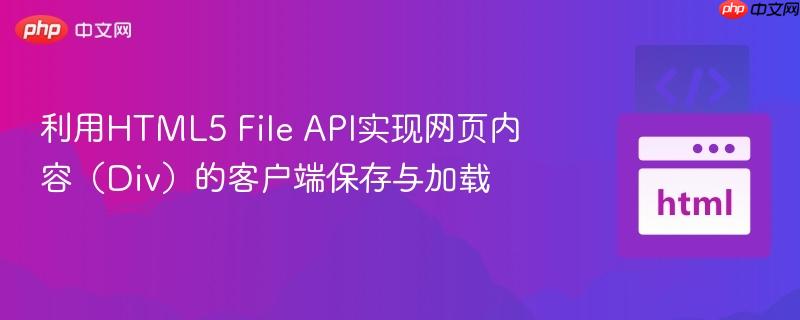
本文详细介绍了如何利用html5的file api在客户端实现将网页中特定`div`元素的内容保存为本地文件,以及从本地文件加载内容并更新`div`元素。教程涵盖了核心javascript代码、html结构,并提供了完整的示例,旨在帮助开发者理解和应用这些前端技术,实现网页内容的本地化交互。
在现代Web应用开发中,有时我们需要在不涉及服务器端交互的情况下,允许用户保存或加载页面上的动态内容。HTML5的File API为我们提供了强大的客户端能力,可以直接在浏览器中处理文件。本教程将深入探讨如何利用这一API,实现将特定div元素的内容保存为本地文件,以及从本地文件读取内容并将其加载到div中。
在开始之前,我们需要确保浏览器支持HTML5 File API。这是一个重要的前提,因为如果浏览器不支持,相关功能将无法使用。
function checkFileAPI() {
if (window.File && window.FileReader && window.FileList && window.Blob) {
return true;
} else {
alert('您的浏览器不支持完整的File API。请升级或使用更现代的浏览器。');
return false;
}
}
// 在文档加载完成后调用检查
$(document).ready(function() {
checkFileAPI();
});这段代码定义了一个checkFileAPI函数,用于检查window对象中是否存在File、FileReader、FileList和Blob等核心接口。如果缺少任何一个,则提示用户浏览器不支持。
将div元素的内容保存为本地文件主要利用了HTML5的zuojiankuohaophpcna>标签的download属性和data: URI方案。
立即学习“前端免费学习笔记(深入)”;
<div id="contents">
这里是将被保存的Div内容。
</div>
<button type="button" id="downloadInput" class="btn">保存内容</button>
<script>
$(document).ready(function() {
$("#downloadInput").click(function(){
var element = document.createElement('a');
var filecontents = $('#contents').html(); // 获取Div的HTML内容
// 对内容进行编码,以确保特殊字符正确处理
element.setAttribute('href', 'data:text/html;charset=utf-8,' + encodeURIComponent(filecontents));
element.setAttribute('download', 'my_saved_content.html'); // 设置下载的文件名和格式
element.style.display = 'none'; // 隐藏链接
document.body.appendChild(element); // 添加到DOM
element.click(); // 模拟点击触发下载
document.body.removeChild(element); // 下载后移除链接
});
});
</script>在这个例子中,我们获取id为contents的div的HTML内容,将其编码后作为data: URI的href,并指定下载文件名为my_saved_content.html。用户点击“保存内容”按钮后,浏览器会下载这个文件。
从本地文件加载内容到div主要依赖于FileReader对象,它允许Web应用程序异步读取存储在用户计算机上的文件(或原始数据缓冲区)的内容。
<div id="contents">
这里是将被加载内容替换的Div。
</div>
<input type="file" id="fileInput" class="btn">
<script>
$(document).ready(function() {
$("#fileInput").change(function(){
if (this.files && this.files[0]) { // 确保有文件被选择
var reader = new FileReader(); // 创建FileReader实例
reader.onload = function (e) {
// 文件读取成功后,e.target.result包含文件内容
$("#contents").html(e.target.result); // 更新Div内容
};
reader.readAsText(this.files[0]); // 以文本格式读取文件
}
});
});
</script>在这个例子中,当用户通过id为fileInput的文件输入框选择一个文件后,change事件会触发。FileReader会异步读取文件的文本内容,并在读取完成后,将内容更新到id为contents的div中。
以下是一个将保存和加载功能结合在一起的完整HTML页面示例:
<!DOCTYPE html>
<html>
<head>
<title>Div内容客户端保存与加载</title>
<script src="https://code.jquery.com/jquery-3.6.0.min.js"></script>
<style>
body { font-family: Arial, sans-serif; margin: 20px; }
#contents {
border: 1px solid #ccc;
padding: 15px;
min-height: 100px;
margin-bottom: 20px;
background-color: #f9f9f9;
}
.btn {
padding: 10px 15px;
margin-right: 10px;
cursor: pointer;
border: 1px solid #007bff;
background-color: #007bff;
color: white;
border-radius: 4px;
font-size: 16px;
}
.btn:hover {
background-color: #0056b3;
border-color: #0056b3;
}
input[type="file"] {
border: 1px solid #ccc;
padding: 8px;
border-radius: 4px;
background-color: #f0f0f0;
}
</style>
</head>
<body>
<h1>Div内容客户端操作示例</h1>
<div id="contents" contenteditable="true">
<p>您可以在这里编辑内容,然后尝试保存或加载。</p>
<ul>
<li>列表项1</li>
<li>列表项2</li>
</ul>
<strong>加粗文本</strong>
</div>
<input type="file" id="fileInput" class="btn">
<button type="button" id="downloadInput" class="btn">保存Div内容为HTML</button>
<script>
// 检查File API兼容性
function checkFileAPI() {
if (window.File && window.FileReader && window.FileList && window.Blob) {
return true;
} else {
alert('您的浏览器不支持完整的File API。请升级或使用更现代的浏览器。');
return false;
}
}
$(document).ready(function() {
if (!checkFileAPI()) {
// 如果API不支持,可以禁用相关按钮
$("#fileInput").prop('disabled', true);
$("#downloadInput").prop('disabled', true);
return;
}
// 加载文件到Div
$("#fileInput").change(function(){
if (this.files && this.files[0]) {
var reader = new FileReader();
reader.onload = function (e) {
$("#contents").html(e.target.result);
};
reader.readAsText(this.files[0]);
}
});
// 保存Div内容为文件
$("#downloadInput").click(function(){
var element = document.createElement('a');
var filecontents = $('#contents').html(); // 获取Div的HTML内容
// 将内容编码为URI组件
element.setAttribute('href', 'data:text/html;charset=utf-8,' + encodeURIComponent(filecontents));
element.setAttribute('download', 'my_div_content.html'); // 设置下载文件名
element.style.display = 'none';
document.body.appendChild(element);
element.click();
document.body.removeChild(element);
});
});
</script>
</body>
</html>在这个完整的示例中,我们还为div添加了contenteditable="true"属性,使其可以直接在页面上编辑,方便用户测试保存和加载功能。
通过HTML5 File API,我们可以实现在客户端对div内容进行保存和加载的强大功能,极大地增强了Web应用的交互性和用户体验。无论是将动态生成的内容保存到本地,还是从本地文件恢复工作状态,这些技术都为前端开发者提供了灵活的解决方案。然而,在使用这些功能时,务必注意浏览器兼容性、内容安全以及文件大小等限制,并根据实际需求选择最合适的实现方案。
以上就是利用HTML5 File API实现网页内容(Div)的客户端保存与加载的详细内容,更多请关注php中文网其它相关文章!

HTML怎么学习?HTML怎么入门?HTML在哪学?HTML怎么学才快?不用担心,这里为大家提供了HTML速学教程(入门课程),有需要的小伙伴保存下载就能学习啦!

Copyright 2014-2025 https://www.php.cn/ All Rights Reserved | php.cn | 湘ICP备2023035733号